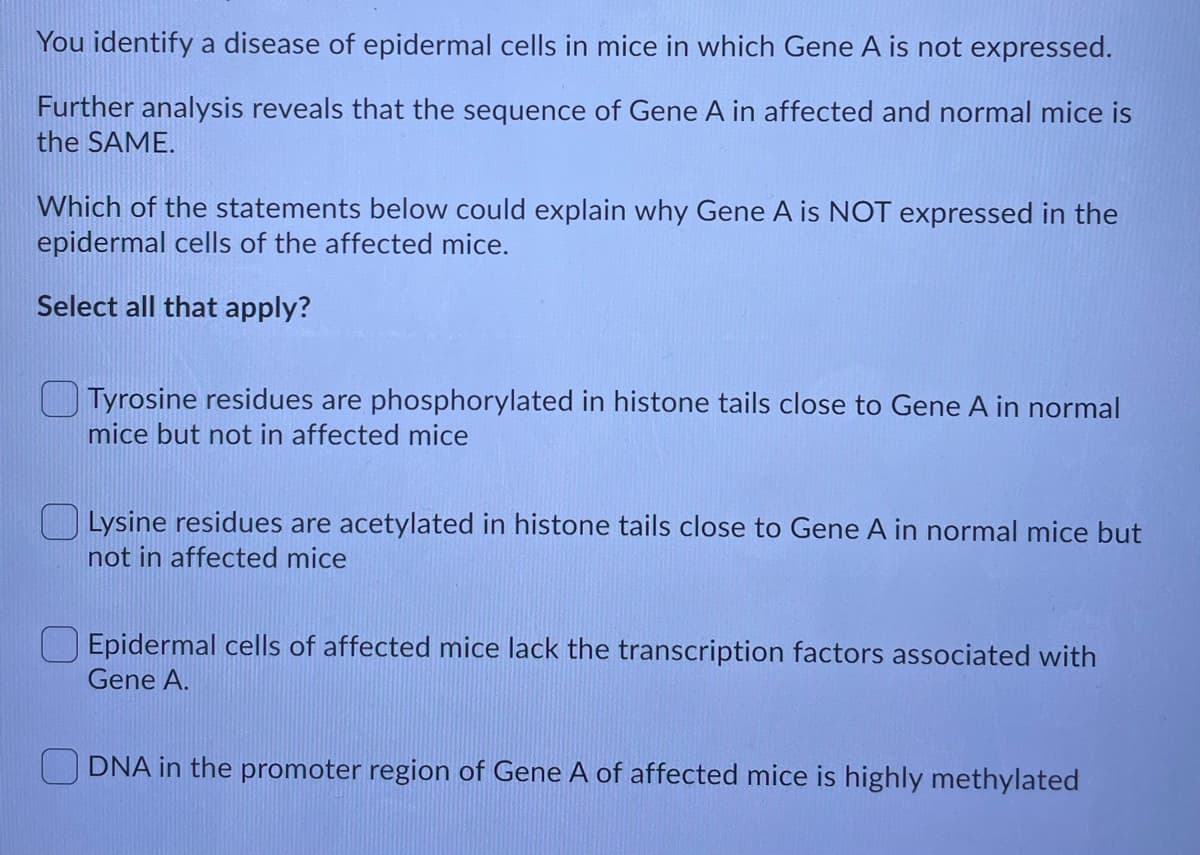You identify a disease of epidermal cells in mice in which Gene A is not expressed. Further analysis reveals that the sequence of Gene A in affected and normal mice is the SAME. Which of the statements below could explain why Gene A is NOT expressed in the epidermal cells of the affected mice. Select all that apply? Tyrosine residues are phosphorylated in histone tails close to Gene A in normal mice but not in affected mice Lysine residues are acetylated in histone tails close to Gene A in normal mice but not in affected mice Epidermal cells of affected mice lack the transcription factors associated with Gene A. DNA in the promoter region of Gene A of affected mice is highly methylated
You identify a disease of epidermal cells in mice in which Gene A is not expressed. Further analysis reveals that the sequence of Gene A in affected and normal mice is the SAME. Which of the statements below could explain why Gene A is NOT expressed in the epidermal cells of the affected mice. Select all that apply? Tyrosine residues are phosphorylated in histone tails close to Gene A in normal mice but not in affected mice Lysine residues are acetylated in histone tails close to Gene A in normal mice but not in affected mice Epidermal cells of affected mice lack the transcription factors associated with Gene A. DNA in the promoter region of Gene A of affected mice is highly methylated
Human Heredity: Principles and Issues (MindTap Course List)
11th Edition
ISBN:9781305251052
Author:Michael Cummings
Publisher:Michael Cummings
Chapter11: Genome Alterations: Mutation And Epigenetics
Section: Chapter Questions
Problem 10QP: If the coding region of a gene (the exons) contains 2,100 base pairs of DNA, would a missense...
Related questions
Concept explainers
Gene Interactions
When the expression of a single trait is influenced by two or more different non-allelic genes, it is termed as genetic interaction. According to Mendel's law of inheritance, each gene functions in its own way and does not depend on the function of another gene, i.e., a single gene controls each of seven characteristics considered, but the complex contribution of many different genes determine many traits of an organism.
Gene Expression
Gene expression is a process by which the instructions present in deoxyribonucleic acid (DNA) are converted into useful molecules such as proteins, and functional messenger ribonucleic (mRNA) molecules in the case of non-protein-coding genes.
Topic Video
Question

Transcribed Image Text:You identify a disease of epidermal cells in mice in which Gene A is not expressed.
Further analysis reveals that the sequence of Gene A in affected and normal mice is
the SAME.
Which of the statements below could explain why Gene A is NOT expressed in the
epidermal cells of the affected mice.
Select all that apply?
Tyrosine residues are phosphorylated in histone tails close to Gene A in normal
mice but not in affected mice
O Lysine residues are acetylated in histone tails close to Gene A in normal mice but
not in affected mice
Epidermal cells of affected mice lack the transcription factors associated with
Gene A.
DNA in the promoter region of Gene A of affected mice is highly methylated
Expert Solution
This question has been solved!
Explore an expertly crafted, step-by-step solution for a thorough understanding of key concepts.
Step by step
Solved in 2 steps

Knowledge Booster
Learn more about
Need a deep-dive on the concept behind this application? Look no further. Learn more about this topic, biology and related others by exploring similar questions and additional content below.Recommended textbooks for you

Human Heredity: Principles and Issues (MindTap Co…
Biology
ISBN:
9781305251052
Author:
Michael Cummings
Publisher:
Cengage Learning

Human Heredity: Principles and Issues (MindTap Co…
Biology
ISBN:
9781305251052
Author:
Michael Cummings
Publisher:
Cengage Learning